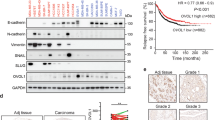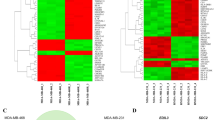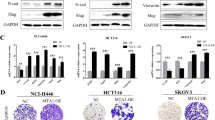Abstract
The epithelial–mesenchymal transition (EMT) bestows cancer cells with increased stem cell properties and metastatic potential. To date, multiple extracellular stimuli and transcription factors have been shown to regulate EMT. Many of them are not druggable and therefore it is necessary to identify targets, which can be inhibited using small molecules to prevent metastasis. Recently, we identified the ganglioside GD2 as a novel breast cancer stem cell marker. Moreover, we found that GD3 synthase (GD3S)—an enzyme involved in GD2 biosynthesis—is critical for GD2 production and could serve as a potential druggable target for inhibiting tumor initiation and metastasis. Indeed, there is a small molecule known as triptolide that has been shown to inhibit GD3S function. Accordingly, in this manuscript, we demonstrate that the inhibition of GD3S using small hairpin RNA or triptolide compromises the initiation and maintenance of EMT instigated by various signaling pathways, including Snail, Twist and transforming growth factor-β1 as well as the mesenchymal characteristics of claudin-low breast cancer cell lines (SUM159 and MDA-MB-231). Moreover, GD3S is necessary for wound healing, migration, invasion and stem cell properties in vitro. Most importantly, inhibition of GD3S in vivo prevents metastasis in experimental as well as in spontaneous syngeneic wild-type mouse models. We also demonstrate that the transcription factor FOXC2, a central downstream effector of several EMT pathways, directly regulates GD3S expression by binding to its promoter. In clinical specimens, the expression of GD3S correlates with poor prognosis in triple-negative human breast tumors. Moreover, GD3S expression correlates with activation of the c-Met signaling pathway leading to increased stem cell properties and metastatic competence. Collectively, these findings suggest that the GD3S-c-Met axis could serve as an effective target for the treatment of metastatic breast cancers.
This is a preview of subscription content, access via your institution
Access options
Subscribe to this journal
Receive 50 print issues and online access
$259.00 per year
only $5.18 per issue
Buy this article
- Purchase on Springer Link
- Instant access to full article PDF
Prices may be subject to local taxes which are calculated during checkout





Similar content being viewed by others
References
Hay ED . An overview of epithelio-mesenchymal transformation. Acta Anat (Basel) 1995; 154: 8–20.
Thiery JP, Acloque H, Huang RY, Nieto MA . Epithelial-mesenchymal transitions in development and disease. Cell 2009; 139: 871–890.
Haynes J, Srivastava J, Madson N, Wittmann T, Barber DL . Dynamic actin remodeling during epithelial-mesenchymal transition depends on increased moesin expression. Mol Biol Cell 2011; 22: 4750–4764.
Kiemer AK, Takeuchi K, Quinlan MP . Identification of genes involved in epithelial-mesenchymal transition and tumor progression. Oncogene 2001; 20: 6679–6688.
Vincent-Salomon A, Thiery JP . Host microenvironment in breast cancer development: epithelial-mesenchymal transition in breast cancer development. Breast Cancer Res 2003; 5: 101–106.
Xue C, Plieth D, Venkov C, Xu C, Neilson EG . The gatekeeper effect of epithelial-mesenchymal transition regulates the frequency of breast cancer metastasis. Cancer Res 2003; 63: 3386–3394.
Janda E, Lehmann K, Killisch I, Jechlinger M, Herzig M, Downward J et al. Ras and TGF[beta] cooperatively regulate epithelial cell plasticity and metastasis: dissection of Ras signaling pathways. J Cell Biol 2002; 156: 299–313.
Oft M, Peli J, Rudaz C, Schwarz H, Beug H, Reichmann E . TGF-beta1 and Ha-Ras collaborate in modulating the phenotypic plasticity and invasiveness of epithelial tumor cells. Genes Dev 1996; 10: 2462–2477.
Birchmeier C, Birchmeier W, Gherardi E, Vande Woude GF . Met, metastasis, motility and more. Nat Rev Mol Cell Biol 2003; 4: 915–925.
Yang J, Mani SA, Donaher JL, Ramaswamy S, Itzykson RA, Come C et al. Twist, a master regulator of morphogenesis, plays an essential role in tumor metastasis. Cell 2004; 117: 927–939.
Cano A, Perez-Moreno MA, Rodrigo I, Locascio A, Blanco MJ, del Barrio MG et al. The transcription factor snail controls epithelial-mesenchymal transitions by repressing E-cadherin expression. Nat Cell Biol 2000; 2: 76–83.
Hartwell KA, Muir B, Reinhardt F, Carpenter AE, Sgroi DC, Weinberg RA . The Spemann organizer gene, Goosecoid, promotes tumor metastasis. Proc Natl Acad Sci USA 2006; 103: 18969–18974.
Onder TT, Gupta PB, Mani SA, Yang J, Lander ES, Weinberg RA . Loss of E-cadherin promotes metastasis via multiple downstream transcriptional pathways. Cancer Res 2008; 68: 3645–3654.
Huber MA, Kraut N, Beug H . Molecular requirements for epithelial-mesenchymal transition during tumor progression. Curr Opin Cell Biol 2005; 17: 548–558.
Zavadil J, Cermak L, Soto-Nieves N, Bottinger EP . Integration of TGF-beta/Smad and Jagged1/Notch signalling in epithelial-to-mesenchymal transition. EMBO J 2004; 23: 1155–1165.
Bates RC, Mercurio AM . Tumor necrosis factor-alpha stimulates the epithelial-to-mesenchymal transition of human colonic organoids. Mol Biol Cell 2003; 14: 1790–1800.
Fillmore CM, Kuperwasser C . Human breast cancer cell lines contain stem-like cells that self-renew, give rise to phenotypically diverse progeny and survive chemotherapy. Breast Cancer Res 2008; 10: R25.
Gupta PB, Onder TT, Jiang G, Tao K, Kuperwasser C, Weinberg RA et al. Identification of selective inhibitors of cancer stem cells by high-throughput screening. Cell 2009; 138: 645–659.
Mani SA, Guo W, Liao MJ, Eaton EN, Ayyanan A, Zhou AY et al. The epithelial-mesenchymal transition generates cells with properties of stem cells. Cell 2008; 133: 704–715.
Morel AP, Lievre M, Thomas C, Hinkal G, Ansieau S, Puisieux A . Generation of breast cancer stem cells through epithelial-mesenchymal transition. PLoS ONE 2008; 3: e2888.
Li X, Lewis MT, Huang J, Gutierrez C, Osborne CK, Wu MF et al. Intrinsic resistance of tumorigenic breast cancer cells to chemotherapy. J Natl Cancer Inst 2008; 100: 672–679.
Creighton CJ, Li X, Landis M, Dixon JM, Neumeister VM, Sjolund A et al. Residual breast cancers after conventional therapy display mesenchymal as well as tumor-initiating features. Proc Natl Acad Sci USA 2009; 106: 13820–13825.
Battula VL, Evans KW, Hollier BG, Shi Y, Marini FC, Ayyanan A et al. Epithelial-mesenchymal transition-derived cells exhibit multilineage differentiation potential similar to mesenchymal stem cells. Stem Cells 2010; 28: 1435–1445.
Battula VL, Shi Y, Evans KW, Wang RY, Spaeth EL, Jacamo RO et al. Ganglioside GD2 identifies breast cancer stem cells and promotes tumorigenesis. J Clin Invest 2012; 122: 2066–2078.
Schmidt C, Bladt F, Goedecke S, Brinkmann V, Zschiesche W, Sharpe M et al. Scatter factor/hepatocyte growth factor is essential for liver development. Nature 1995; 373: 699–702.
Bladt F, Riethmacher D, Isenmann S, Aguzzi A, Birchmeier C . Essential role for the c-met receptor in the migration of myogenic precursor cells into the limb bud. Nature 1995; 376: 768–771.
Zhang YW, Vande Woude GF . HGF/SF-met signaling in the control of branching morphogenesis and invasion. J Cell Biochem 2003; 88: 408–417.
van Leenders GJ, Sookhlall R, Teubel WJ, de Ridder CM, Reneman S, Sacchetti A et al. Activation of c-MET induces a stem-like phenotype in human prostate cancer. PLoS ONE 2011; 6: e26753.
Ma PC, Tretiakova MS, Nallasura V, Jagadeeswaran R, Husain AN, Salgia R . Downstream signalling and specific inhibition of c-MET/HGF pathway in small cell lung cancer: implications for tumour invasion. Br J Cancer 2007; 97: 368–377.
Di Renzo MF, Poulsom R, Olivero M, Comoglio PM, Lemoine NR . Expression of the Met/hepatocyte growth factor receptor in human pancreatic cancer. Cancer Res 1995; 55: 1129–1138.
Tsao MS, Liu N, Chen JR, Pappas J, Ho J, To C et al. Differential expression of Met/hepatocyte growth factor receptor in subtypes of non-small cell lung cancers. Lung Cancer 1998; 20: 1–16.
Schmidt L, Duh FM, Chen F, Kishida T, Glenn G, Choyke P et al. Germline and somatic mutations in the tyrosine kinase domain of the MET proto-oncogene in papillary renal carcinomas. Nat Genet 1997; 16: 68–73.
Tuck AB, Park M, Sterns EE, Boag A, Elliott BE . Coexpression of hepatocyte growth factor and receptor (Met) in human breast carcinoma. Am J Pathol 1996; 148: 225–232.
Cazet A, Lefebvre J, Adriaenssens E, Julien S, Bobowski M, Grigoriadis A et al. GD(3) synthase expression enhances proliferation and tumor growth of MDA-MB-231 breast cancer cells through c-Met activation. Mol Cancer Res 2010; 8: 1526–1535.
Kwon HY, Kim SJ, Kim CH, Son SW, Kim KS, Lee JH et al. Triptolide downregulates human GD3 synthase (hST8Sia I) gene expression in SK-MEL-2 human melanoma cells. Exp Mol Med 2010; 42: 849–855.
Debnath J, Muthuswamy SK, Brugge JS . Morphogenesis and oncogenesis of MCF-10A mammary epithelial acini grown in three-dimensional basement membrane cultures. Methods 2003; 30: 256–268.
Hollier BG, Tinnirello AA, Werden SJ, Evans KW, Taube JH, Sarkar TR et al. FOXC2 expression links epithelial-mesenchymal transition and stem cell properties in breast cancer. Cancer Res 2013; 73: 1981–1992.
Hao L, Zhi-Hong L, Zhao-Hong C, Jun-Wei Y, Lei-Shi L . Triptolide a potent inhibitor of NF-kB in T lymphocytes. Acta Pharmacol Sin 2000; 21: 782–786.
Yu YH, Chen HA, Chen PS, Cheng YJ, Hsu WH, Chang YW et al. MiR-520h-mediated FOXC2 regulation is critical for inhibition of lung cancer progression by resveratrol. Oncogene 2013; 32: 431–443.
Li Y, Li A, Glas M, Lal B, Ying M, Sang Y . c-Met signaling induces a reprogramming network and supports the glioblastoma stem-like phenotype. Proc Natl Acad Sci USA 2011; 108: 9951–9956.
Kiviharju TM, Lecane PS, Sellers RG, Peehl DM . Antiproliferative and proapoptotic activities of triptolide (PG490), a natural product entering clinical trials, on primary cultures of human prostatic epithelial cells. Clin Cancer Res 2002; 8: 2666–2674.
Stewart SA, Dykxhoorn DM, Palliser D, Mizuno H, Yu EY, An DS et al. Lentivirus-delivered stable gene silencing by RNAi in primary cells. RNA 2003; 9: 493–501.
Guo W, Keckesova Z, Donaher JL, Shibue T, Tischler V, Reinhardt F et al. Slug and Sox9 cooperatively determine the mammary stem cell state. Cell 2012; 148: 1015–1028.
Acknowledgements
We acknowledge the entire Mani Lab for invaluable suggestions and discussions, and Thiru Arumugam for his valuable help in animal imaging. This work was supported by an MD Anderson Research Trust Fellow Award, funded by the George and Barbara Bush Endowment for Innovative Cancer Research (SAM). Flow cytometry, confocal microscopy and animal imaging were in part funded by the Cancer Center Support Grant from the National Cancer Institute (CA16672). We also acknowledge support from the Breast Cancer Research Foundation (MA) and the Rolanette and Berdon Lawrence Research award from Bone Disease Program of Texas (VLB).
Author information
Authors and Affiliations
Corresponding authors
Ethics declarations
Competing interests
TRS, VLB, MA and SAM are inventors of a patent application based on the work described here. The remaining authors declare no conflict of interest.
Additional information
Supplementary Information accompanies this paper on the Oncogene website
Rights and permissions
About this article
Cite this article
Sarkar, T., Battula, V., Werden, S. et al. GD3 synthase regulates epithelial–mesenchymal transition and metastasis in breast cancer. Oncogene 34, 2958–2967 (2015). https://doi.org/10.1038/onc.2014.245
Received:
Revised:
Accepted:
Published:
Issue Date:
DOI: https://doi.org/10.1038/onc.2014.245
This article is cited by
-
Glycosphingolipids in human embryonic stem cells and breast cancer stem cells, and potential cancer therapy strategies based on their structures and functions
Glycoconjugate Journal (2022)
-
Analysis of biochemical features of ST8 α-N-acetyl-neuraminide α2,8-sialyltransferase (St8sia) 5 isoforms
Glycoconjugate Journal (2022)
-
Structure and function of glycosphingolipids on small extracellular vesicles
Glycoconjugate Journal (2022)
-
ST8SIA1 inhibition sensitizes triple negative breast cancer to chemotherapy via suppressing Wnt/β-catenin and FAK/Akt/mTOR
Clinical and Translational Oncology (2021)
-
Recent advances in understanding the roles of sialyltransferases in tumor angiogenesis and metastasis
Glycoconjugate Journal (2021)



